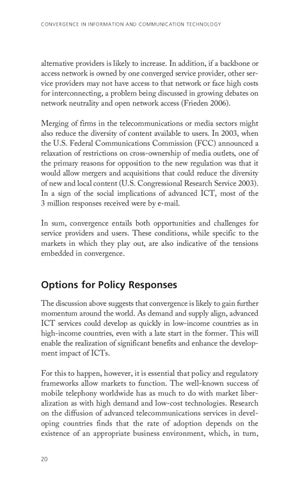CONVERGENCE IN INFORMATION AND COMMUNICATION TECHNOLOGY
alternative providers is likely to increase. In addition, if a backbone or access network is owned by one converged service provider, other service providers may not have access to that network or face high costs for interconnecting, a problem being discussed in growing debates on network neutrality and open network access (Frieden 2006). Merging of firms in the telecommunications or media sectors might also reduce the diversity of content available to users. In 2003, when the U.S. Federal Communications Commission (FCC) announced a relaxation of restrictions on cross-ownership of media outlets, one of the primary reasons for opposition to the new regulation was that it would allow mergers and acquisitions that could reduce the diversity of new and local content (U.S. Congressional Research Service 2003). In a sign of the social implications of advanced ICT, most of the 3Â million responses received were by e-mail. In sum, convergence entails both opportunities and challenges for service providers and users. These conditions, while specific to the markets in which they play out, are also indicative of the tensions embedded in convergence.
Options for Policy Responses The discussion above suggests that convergence is likely to gain further momentum around the world. As demand and supply align, advanced ICT services could develop as quickly in low-income countries as in high-income countries, even with a late start in the former. This will enable the realization of significant benefits and enhance the development impact of ICTs. For this to happen, however, it is essential that policy and regulatory frameworks allow markets to function. The well-known success of mobile telephony worldwide has as much to do with market liberalization as with high demand and low-cost technologies. Research on the diffusion of advanced telecommunications services in developing countries finds that the rate of adoption depends on the existence of an appropriate business environment, which, in turn, 20
